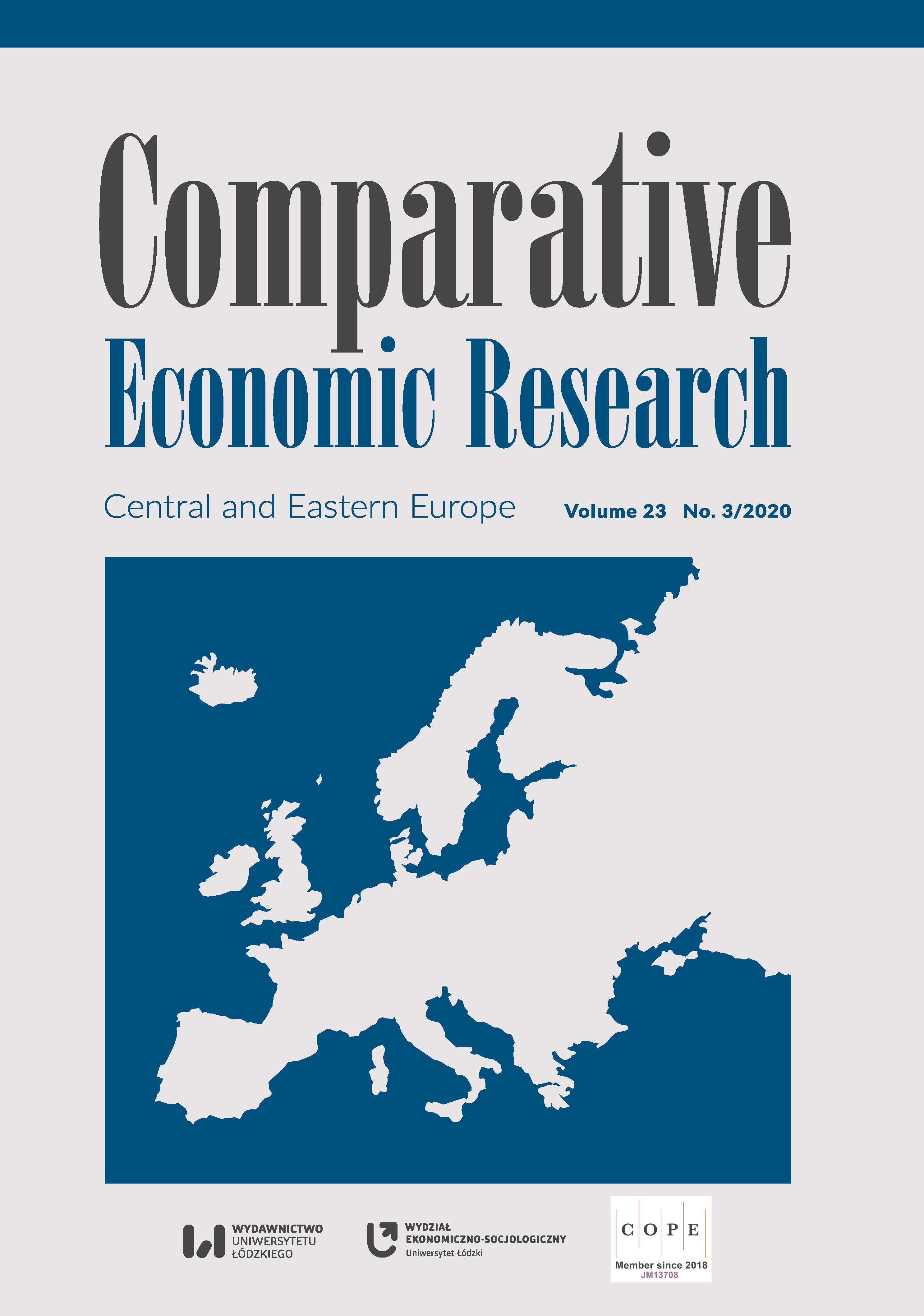Labour Market Institutions and Income Inequalities in the Visegrad Group Countries
DOI:
https://doi.org/10.18778/1508-2008.23.21Keywords:
income inequalities, labour market, institutionsAbstract
The diversity of the labour market in the Visegrad Group countries is presented in the article from an institutional perspective. Institutions such as different tax and transfer policies, employment protection legislation, or active and passive labour market policies can affect not only the effectiveness of the economy from a macro perspective, but they can also be crucial in determining the system of rules and incentives for earning money. The institutional conditions of the labour market directly affect the behaviour of labour market participants, their incomes, and therefore income inequalities. To asses and compare the situation between the Visegrad group countries, a synthetic measure of labour market institutions is calculated. A taxonomic analysis is done to group the V4 countries against other selected European Union countries, which enables the assessment and comparison of similarities and differences across the Visegrad countries. Finally, the trade-offs between a synthetic measure of labour market institutions and income inequalities are analysed. The Pearson correlation coefficient and, additionally, the Spearman’s rank correlation coefficient are applied. The analysis is done for 2016, as it was the most recent data available while writing the article. The results from such an analysis can help to answer the question of the state’s role in limiting income inequalities through labour market institutions and to identify the policies which are the most effective in this field.
Downloads
References
Acemoglu, D. (2003), Cross-country Inequality, “The Economic Journal”, 113. https://doi.org/10.1111/1468-0297.00100
Google Scholar
DOI: https://doi.org/10.1111/1468-0297.00100
Berg, J. (2015), Labour market institutions: the building blocks of just societies, Labour Markets, Institutions and Inequality Building Just Societies in the 21st Century, International Labour Office, Geneva, Switzerland.
Google Scholar
Betcherman, G. (2013), Labour Market Institutions: A Review of the Literature, World Development Report, World Bank.
Google Scholar
Burniaux, J., Padrini, F., Brandt, N. (2006), Labour Market Performance, Income Inequality and Poverty in OECD Countries, OECD Economic Department Working Papers No. 500, OECD, Paris.
Google Scholar
Checchi, D., García-Peñalosa, C. (2008), Labour market institutions and income inequality, “LIS Working Paper Series”, 470, Luxembourg Income Study (LIS), Luxembourg. https://doi.org/10.1111/j.1468-0327.2008.00209.x
Google Scholar
DOI: https://doi.org/10.1111/j.1468-0327.2008.00209.x
Checchi, D., Garcia-Peñalosa, C. (2010), Labour Market Institutions and the Personal Distribution of Income in OECD Countries, “IZA Discussion Paper”, 1681. https://doi.org/10.1111/j.1468-0335.2009.00776.x
Google Scholar
DOI: https://doi.org/10.1111/j.1468-0335.2009.00776.x
Eurostat (2018), https://ec.europa.eu/eurostat/cache/metadata/fr/lmp_esms.htm (accessed: 15.10.2018).
Google Scholar
Everitt, B., Landau, S., Leese, M., Stahl, D. (2011), Cluster analysis, Wiley. https://doi.org/10.1002/9780470977811
Google Scholar
DOI: https://doi.org/10.1002/9780470977811
Gaweł, T., Klimczak, M. (2005), Pojęcie instytucji w prawie i ekonomii, “Economics and Law”, 1 (1).
Google Scholar
Heritage Foundation (2018a), https://www.heritage.org/index/pdf/2018/book/methodology.pdf (accessed: 15.10.2018).
Google Scholar
Heritage Foundation (2018b), https://www.heritage.org/index/labor-freedom (accessed: 15.10.2018).
Google Scholar
Higgins, N., Pica, G. (2017), Complementarities between labour market institutions and their causal impact on youth labour market outcomes, “Employment Working Paper”, 224, International Labour Office.
Google Scholar
Horwath, H., Szalai, Z. (2008), Labour market institutions in Hungary with a focus on wage and employment flexibility, “Occasional Papers 77”, Magyar Nemzeti Bank.
Google Scholar
Koeniger, W., Leonardi, M., Nunziata, L. (2004), Labour Market Institutions and Wage Inequality, “IZA Discussion Paper”, 1291.
Google Scholar
DOI: https://doi.org/10.2139/ssrn.588141
Kolenda, M. (2006), Taksonomia numeryczna, Klasyfikacja, porządkowanie i analiza obiektów wielocechowych, Wydawnictwo Akademii Ekonomicznej we Wrocławiu.
Google Scholar
Mirkin, B. (2005), Clustering for Data Mining: A Data Recovery Approach, Chapman & Hall/CRC Computer Science & Data Analysis, PB CRC Press.
Google Scholar
North, D.C. (1994), Institutional Change: A Framework of Analysis, Economic History.
Google Scholar
DOI: https://doi.org/10.1515/9780804766166-008
North, D.C. (2005), Understanding the Process of Economic Change, Princeton University Press, Princeton.
Google Scholar
OECD (2012), Income inequality and growth: The role of taxes and transfers, OECD Economics Department Policy Notes, No. 9. January 2012.
Google Scholar
OECD (2018a), Income Distribution Database, https://stats.oecd.org/Index.aspx?DataSetCode=IDD (accessed: 5.10.2018).
Google Scholar
OECD (2018b), Employment Protection Legislation: Strictness of employment protection legislation: regular employment, OECD Employment and Labour Market Statistics (database) (accessed: 5.10.2018).
Google Scholar
Ostrom, E. (2005), Understanding Institutional Diversity, Princeton University Press, Princeton. https://doi.org/10.1515/9781400831739
Google Scholar
DOI: https://doi.org/10.1515/9781400831739
Ostrom, E. (2011), Background on the Institutional Analysis and Development Framework, “The Policy Studies Journal”, 39 (1). https://doi.org/10.1111/j.1541-0072.2010.00394.x
Google Scholar
DOI: https://doi.org/10.1111/j.1541-0072.2010.00394.x
Szczepaniak, M., Szulc-Obłoza, A. (2019), Labour Market Institutions and Income Inequalities across the European Union, “Economics and Law”, 18 (3). https://doi.org/10.12775/EiP.2019.025
Google Scholar
DOI: https://doi.org/10.12775/EiP.2019.025
The World Bank (2018), Labour Market Efficiency, TCdata 360, https://tcdata360.worldbank.org/indicators/lbr.mkt.efcy?country=BRA&indicator=737&viz=line_chart&years=2007,2017# (accessed: 7.10.2018).
Google Scholar
Wiśniewski, Z. (1999), Kierunki i skutki deregulacji rynku pracy w krajach Unii Europejskiej, Wydawnictwo Uniwersytetu Mikołaja Kopernika, Toruń.
Google Scholar
World Economic Forum (2016), The Global Competitiveness Report 2016–2017, Geneva.
Google Scholar
World Economic Forum (2018), http://reports.weforum.org/global-competitiveness-report-2015-2016/appendix-a-measurement-of-key-concepts-and-preliminary-index-structure/ (accessed: 19.10.2018).
Google Scholar
Zeliaś, A. (ed.) (2000), Taksonomiczna analiza przestrzennego zróżnicowania poziomu życia w Polsce w ujęciu dynamicznym, Wydawnictwo AE, Kraków.
Google Scholar
Downloads
Published
How to Cite
Issue
Section
License

This work is licensed under a Creative Commons Attribution-NonCommercial-NoDerivatives 4.0 International License.











